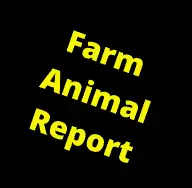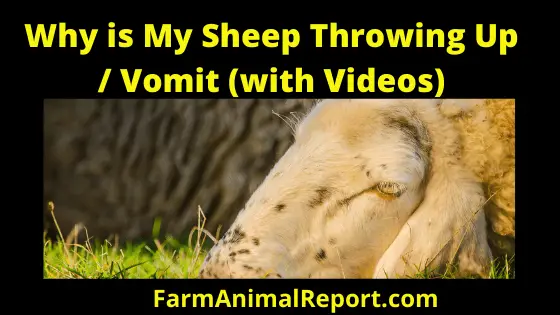Why Are My Sheep Vomiting? If Your Sheep are Throwing up, or Vomiting here are some reasons you can check Through. Toxicity – Has it eaten some poisonous vegetation, or ingested a toxic insect. Is Your Sheep Having Grain Overload, or has it gotten into something with High Copper Levels? The possibility of Pesticide poisoning, or even spoil silage could be the culprit.
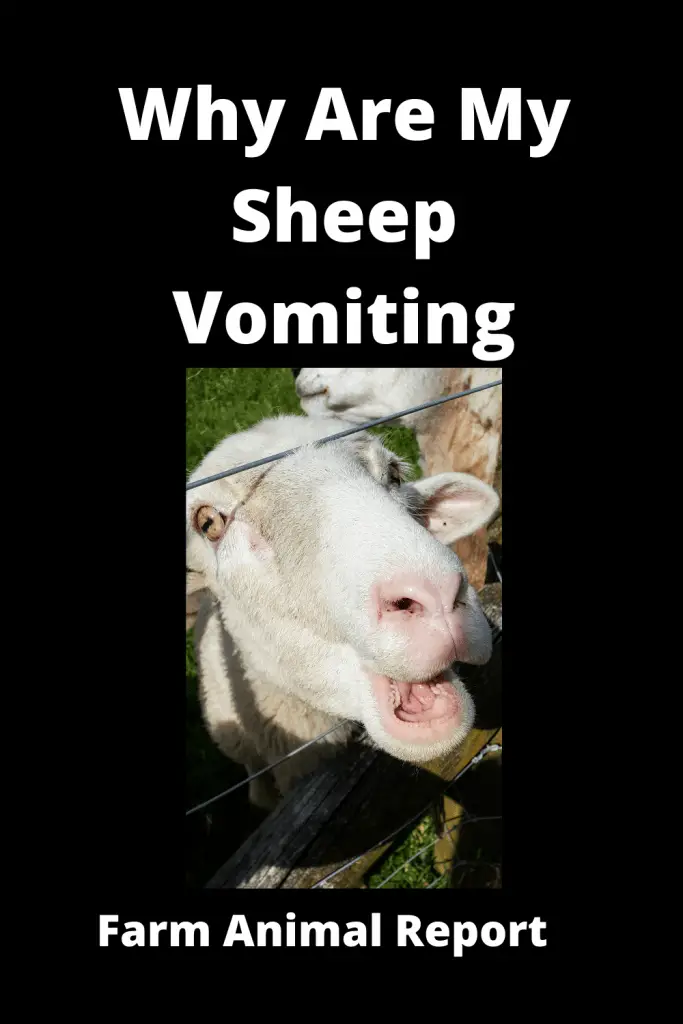
Why Are My Sheep Vomiting? / Sheep Throwing Up
Sheep belong to the ruminant classification of animals. Ruminants are characterized by their four-chambered stomach and “cud-chewing” behavior. Cud is a food bolus that is –
- Regurgitated
- Re – chewed
- Re – swallowed.
They are herbivores, sheep only eat plants and rely on farmers to ensure they have enough pasture, hay, grain, and water to stay healthy. As sheep graze, they eat quickly, only chewing their food briefly, and mixing it with saliva before swallowing.
Rumen / Reticulum / Omasum / Abomasum
The first stop in the digestive process is the rumen (first stomach). The rumen contains digestive juices and millions of microbes that start to break down the food. This process produces lots of gas (including methane), which sheep get rid of by burping. Sheep often appear to be resting as they chew their cud as they are not actively grazing.
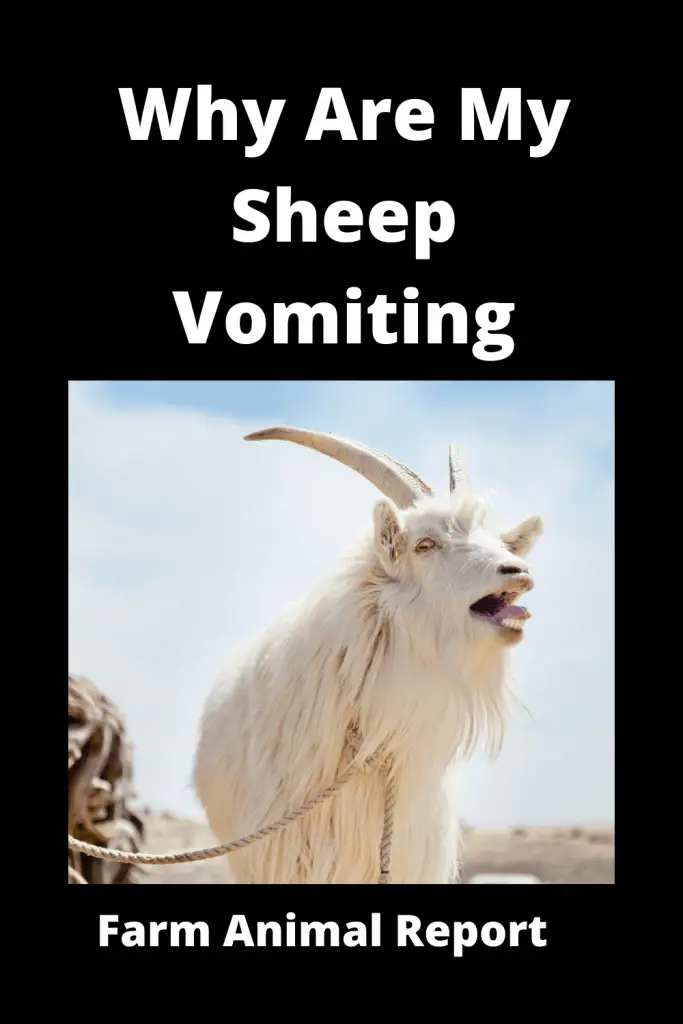
- Graze
- Swallow
- Comes Back Up
- Chewed
- Swallowed Again
This additional chewing helps break the food down further before it is swallowed again, passing into the reticulum (second stomach). The reticulum stores the juices from the chewed–up food, which then passes into the omasum (third stomach). Muscles in the folds of the omasum squeeze the food to remove any remaining liquid.
The food then moves to the abomasum (fourth stomach), where it is mixed and churned with more digestive juices. It then passes into the intestine where nutrients are absorbed into the bloodstream. The remaining waste is excreted as urine and manure.
Cudding is another form of regurgitation, whereby ruminants like us goats, sheep and cattle hark up a bolus of pre-chewed food and chew it again to extract more nutrients.
They regurgitate as part of cudding all the time but usually only vomit if we’ve been accidentally poisoned, so vomiting is a serious issue for us.
The rumen digestive system
The rumen occupies a large percentage of the abdominal cavity of the ruminant. It is a large storage space for food that is quickly consumed, then later regurgitated, re-chewed, and re-swallowed in a process called cud-chewing. Rumination or cud-chewing occurs primarily when the animal is resting and not eating.
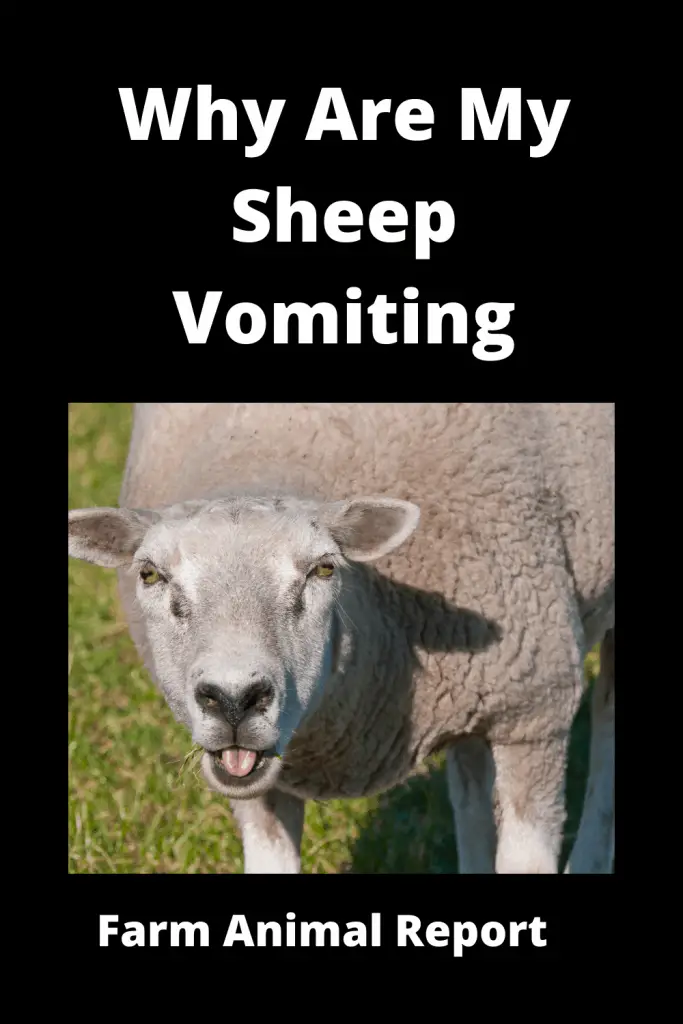
Healthy mature sheep will chew their cuds for several hours each day.
The rumen is a large fermentation vat. It contains billions of microorganisms, including bacteria and protozoa, which allow ruminants to digest fibrous feeds such as grass, hay, and silage that other animals cannot efficiently utilize.
\Fermentation in the rumen produces enormous quantities of gas that ruminants get rid of by belching (burping).
Anything that interferes with belching is life-threatening to the ruminant and may result in a condition called bloat.
Mild cases of bloat can usually be successfully treated with an antacid or sodium bicarbonate.
The reticulum is closely associated with the rumen. Contents mix continually between both sections.
The reticulum looks like a “honeycomb” in appearance. Relatively little digestive activity occurs in the omasum. It is called “many piles” because it contains many layers of tissue. The abomasum is the “true” stomach of the ruminant. It has a similar function as the stomach of a non-ruminant: secretion of enzymes and acids to break down nutrients.
It can be a challenge to ensure sheep residents have healthy, happy lives after coming to a farm, and there are many different aspects of care to consider each day. Unfortunately, toxic and poisonous hazards are sometimes overlooked in the hustle and bustle of operating a farm.
While minor exposure to many of these toxins are unlikely to cause serious problems, large amounts can cause severe health issues and sadly, even death. There are also some toxins that are highly dangerous even in small amounts.
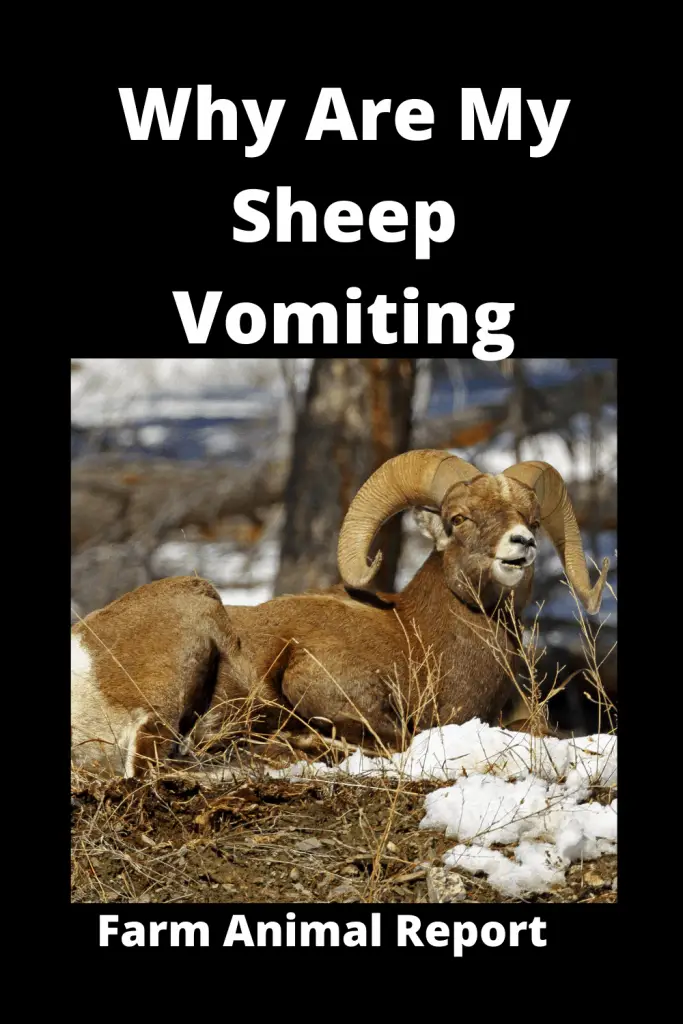
In order to help ensure you never run into this problem, we have compiled this resource of common plants and other potentially toxic things that have been known to be a problem for sheep.
Potential Sheep Toxins
Algae – Toxic to Sheep
Algae; Blue-green algae, which is most often found in stagnant, slow-moving water when temperatures are high, can poison sheep. Symptoms generally develop quite rapidly and may resemble an allergic reaction. Convulsions may occur, but more frequently the sheep sinks to the ground and dies without struggling.
Smaller amounts of poison cause weakness and staggering, followed by recovery. In some instances, apparent recovery from an attack is followed in a few days or weeks by evidence of photosensitization.
There may be inflammation of the muzzle, the skin of the ear, the udder, or other parts of the body. Jaundice is often seen, and constipation is a common symptom. Such cases usually recover under good care.
Blister Beetle – Toxic to Sheep
Cantharidiasis (Blister Beetle Poisoning); Blister beetles contain cantharidin, a toxic substance that is used as a defense mechanism against predators. There are more than 200 different species, and they can be found from Mexico to Southern Canada, and from the east coast of the United States as far west as New Mexico.
Cantharidin can severely injure or kill sheep when even a small amount is ingested. Sheep come into contact with cantharidin by ingesting alfalfa hay that has been infested by blister beetles. The oily substance can contaminate the hay even if the beetles were crushed into the feedstuff. Crushing or chemically eradicating the beetles does not diminish the toxin potency.
Inspecting individual flakes of alfalfa hay before providing them to residents can help reduce the likelihood of poisoning. Dispose of any contaminated flakes, even if you have removed the beetle, as the toxin can still be left behind.
First-cutting hay is less likely to be contaminated than hay harvested later in the year, as the insects likely haven’t yet swarmed by then. Harvest alfalfa before it fully blooms to reduce the chances of beetle contamination. Hay is less likely to be contaminated by crushed beetles when harvested with a self-propelled mower or windrowed. Crimping hay crushes the beetles into the hay.
Sheep that ingest a massive amount of toxin may show signs of severe shock, and unfortunately, die within hours. Symptoms of sublethal poisoning include depression, diarrhea, elevated temperatures, increased pulse and breathing rates, and dehydration. There is also frequent urination, especially after the first 24 hours. If you suspect Blister Beetle Poisoning, contact your veterinarian immediately. If early veterinary care is provided, afflicted sheep have a chance of recovery.
Excess Copper – Toxic to Sheep
Copper; Copper toxicity is especially dangerous in sheep because their liver accumulates copper much more readily than in other animals. Although copper is essential for sheep, too much copper can cause anemia, lack of appetite, fragile bones, lethargy, teeth grinding, jaundice, bloody urine, hair loss, and poor wool coverage.
Sheep are ten times more susceptible to this condition than goats.
Copper can accumulate in a sheep’s liver for a up to a year without any symptoms until the liver releases a large amount at once, causing damage to their red blood cells. Copper toxicity can also be a result of a lack of dietary molybdenum, sulfur, zinc, calcium, or liver damage.
Left untreated, copper toxicity can be fatal in only a few days after presenting symptoms. If you suspect copper toxicity in sheep, contact a veterinarian immediately. Veterinary treatment includes a daily drench of ammonium molybdate and sodium sulfate in specific quantities (too much can cause serious health repercussions).
The best prevention includes ensuring that the sheep are not eating too much copper in their diet. Make sure that sheep are not given access to minerals not explicitly approved for sheep, as even
goat minerals have too much copper for a sheep’s body.
Grain Overload – Toxic to Sheep
Grain Overload (Acidosis, Grain Poisoning); Grain overload occurs when sheep eat large amounts of grain, causing carbohydrates to be released in the rumen and ferment instead of being normally digested.
Lactic acid is produced resulting in slowing of the gut, dehydration, and sometimes death. While wheat and barley are the most common causes of grain overload, lupins and oats can also be the culprit.
Grain overload is most commonly seen where sheep may be in a newly harvested pasture and spilled and unharvested grains remain, and when sheep gain access to bags or cans of grains and pellets. If a sheep isn’t accustomed to eating grain, a sudden switch to grains can cause grain overload as well.
Symptoms of Grain Overload Include:
- Depressed appearance
- Lying down
- Throwing up
- Diarrhea
- Dehydration and thirst
- bloating (of the left side of the abdomen)
- Staggery or tender gait and ‘sawhorse’ stance
- Death
If you suspect a sheep has grain overload, contact your veterinarian immediately. Treatment depends on the severity of the condition. Following grain overload, the rumen lining takes up to six weeks to repair, and some animals may develop secondary infections that will require veterinary treatment.
Hardware Disease – Toxic to Sheep
Hardware Disease; Hardware Disease refers to the injuries that can result from any animal eating something they shouldn’t, especially pieces of human-made hardware like nails, screws, and staples. Hardware disease can have devastating effects on any farm animal.
Pesticides – Toxic to Sheep
Pesticides, Herbicides, And Rodenticides; It may not come as a surprise that herbicides and rodenticides can cause toxicosis in sheep if ingested. If sheep ingest plants that have been sprayed with phenoxy acid herbicides, they can become ill or even die.
For this reason, it is imperative that sheep are not given treated plants or are allowed access to pastures that have been treated with herbicides.
While rats and mice can pose challenges for sanctuaries, it is important to respect them and use compassionate mitigation practices. Many rodenticides are anticoagulants and act by preventing the blood to clot.
These products may be appealing to sheep as well, and they may attempt to lick or eat them if discovered. For this reason, it is imperative that they do not come into contact with these poisons. There are many new and innovative ways to address rodent populations that are more effective and compassionate.
Pesticides may affect the nervous system in sheep and can be fatal if not treated with the antidote. Early treatment is critical. If you suspect a sheep may have ingested any of the poisons above, contact your veterinarian immediately.
Poisonous Plants for Sheep
- Blue lupin (a fungal toxin in lupins can cause lupinosis)
- Bracken (Pteridium esculentum)
- Devilwood (Ageratina adenophora & A. riparia)
- Foxglove (Digitalis purpurea)
- Goat’s rue (Galega officinalis)
- Hemlock (Conium maculatum)
- Jerusalem cherry (Solanum diflorum & S. pseudocapsicum)
- Laburnum
- Macrocarpa (Cupressus macrocarpa)
- Ngaio (myoporium laetum)
- Oak (acorns) (Quercus sp.)
- Oleander
- Orange Cestrum (Cestrum aurantiacum)
- Ragwort (Senecio jacobaea)
- Rhododendron
- Rhubarb
- St John’s Wort (Hypericum perforatum)
- Tutu (Coriaria arborea)
- Yew (Taxus baccata)
Conclusion
If You find Your Sheep vomiting or throwing up. Investigate immediately for obvious sources of poisoning. Finding the Root Problem can Help Your Vet determine the best treatments. But even if you cannot put your finger on the problem quickly – Call Your Vet and get his direction – Poisoning can be fatal to your Sheep.
Sheep Farming for Wool Profitability Table
| Sheep | Lambs / 3 Per Yr | Space Required 20 Sq Feet - Each | Grazing Acres .3 / Sheep | Feed Required / Yr $100 | 15 Lbs Wool / Year | Average Price $ 10 / LB Wool | Total Revenue Possible |
|---|---|---|---|---|---|---|---|
| 1 | 3 | 60 sq ft | .9 acres | $ 300 | 45 lbs | $ 450 | $ 150 |
| 2 | 6 | 120 sq ft | 1.80 acres | $ 600 | 90 lbs | $ 900 | $ 300 |
| 5 | 15 | 300 sq ft | 4.5 acres | $ 1,500 | 225 lbs | $ 2,250 | $ 750 |
| 10 | 30 | 600 sq ft | 9 acres | $ 3,000 | 450 lbs | $ 4,500 | $ 1,500 |
| 20 | 60 | 1200 sq ft | 18 acres | $ 6,000 | 900 lbs | $ 9,000 | $ 3,000 |
| 30 | 90 | 2,700 sq ft | 27 acres | $ 9,000 | 1,350 lbs | $ 13,500 | $ 4,500 |
| 40 | 120 | 4800 sq ft | 36 acres | $ 12,000 | 1,800 lbs | $ 18,000 | $ 6,000 |
| 50 | 150 | 3,000 sq ft | 45 acres | $ 15,000 | 2,250 lbs | $ 22,500 | $ 7,500 |
| 100 | 300 | 6,000 sq ft | 90 acres | $ 30,000 | 4,500 lbs | $ 45,000 | $ 15,000 |
| 200 | 600 | 12,000 sq ft | 180 acres | $ 60,000 | 9,000 lbs | $ 90,000 | $ 30,000 |
Sheep can Produce 2 - 30 lbs of wool per year depending on Breed
Raw washed Wool Runs $ 6 - $ 14 using average $ 10
Feed 5 Months Buying Hay $ 100 rest Grazing
Please Check my Numbers
Sheep Farming for Milk Profitability Table
| Sheep | Lambs / 3 Per Yr | Space Required 20 Sq Feet - Each | Grazing Acres .3 / Sheep | Feed Required / Yr $100 | Wool $ 15 lb / Year | Average Price $ 10 / LB Wool | 90 Gallon/ Yr each ewe | Price $ 30 per Gallon | Total Wool Revenue Possible | Total Revenue Milk and Wool |
|---|---|---|---|---|---|---|---|---|---|---|
| 1 | 3 | 60 sq ft | .9 acres | $ 300 | 45 lbs | $ 450 | 270 | 8100 | $ 150 | 8,250 |
| 2 | 6 | 120 sq ft | 1.80 acres | $ 600 | 90 lbs | $ 900 | 540 | 16,200 | $ 300 | 16,500 |
| 5 | 15 | 300 sq ft | 4.5 acres | $ 1,500 | 225 lbs | $ 2,250 | 1350 | 40,500 | $ 750 | 41,250 |
| 10 | 30 | 600 sq ft | 9 acres | $ 3,000 | 450 lbs | $ 4,500 | 2700 | 81,000 | $ 1,500 | 82,500 |
| 20 | 60 | 1200 sq ft | 18 acres | $ 6,000 | 900 lbs | $ 9,000 | 5400 | 162,000 | $ 3,000 | 165,000 |
| 30 | 90 | 2,700 sq ft | 27 acres | $ 9,000 | 1,350 lbs | $ 13,500 | 8100 | 243,000 | $ 4,500 | 247,500 |
| 40 | 120 | 4800 sq ft | 36 acres | $ 12,000 | 1,800 lbs | $ 18,000 | 10,800 | 324,000 | $ 6,000 | 330,000 |
| 50 | 150 | 3,000 sq ft | 45 acres | $ 15,000 | 2,250 lbs | $ 22,500 | 13,500 | 405,000 | $ 7,500 | 412,500 |
| 100 | 300 | 6,000 sq ft | 90 acres | $ 30,000 | 4,500 lbs | $ 45,000 | 27,000 | 810,000 | $ 15,000 | 825,000 |
| 200 | 600 | 12,000 sq ft | 180 acres | $ 60,000 | 9,000 lbs | $ 90,000 | 54,000 | 1,620,000 | $ 30,000 | 1,650,000 |
Sheep can Produce 1/2 Gallon Milk per day / 180 Day Lactation
Raw Sheep Milk $9 - $25 per Quart - Used $ 30 per Gallon for Table
Feed 5 Months Buying Hay $ 100 rest Grazing
Please Check my Numbers
18 Breeds of Hair Sheep FAQ Table
| Hair Breeds of Sheep | Country Origin | Purpose of Breed | Use | Ewe Weight |
|---|---|---|---|---|
| Katahdins | Caribbean / Maine / Africa | To Graze Power lines / instead of Chemicals | Meat | 120 - 160 lbs |
| Dorper | South Africa | Thrive in Africa / Hot Climate | Meat / Fast Growing | 230 LBs |
| Blackbelly | America | Hot Climates | Meat | 150 LBs |
| St. Croix | Carribean | Came on Ships for Meat for sailors | Meat | 150 lbs |
| Romanovs | Russia | Primarily for Meat | Meat Wool - Double Coated | 110 lbs |
| Blackhead Persian | Africa / Somaila | Bred for High Quanity of Fat | Meat | 120 lbs |
| West African Dwarf | South / Central Africa | Meat | 55 lbs | |
| Red Maasi | East Africa | Bred for Hardiness and parasite Resistance | Meat | 77 Lbs |
| Wiltshire Horn | England | Do not suffer from Flystrike | Meat | 149 lbs |
| Royal White | United States / Texas | Bred for Tender Meat and Disease Resistants | Meat | 175 lbs |
| California Red | Not completely Hair sheep/ Combination of both/ Prod 2 lambs Yr | Meat | 140 lbs | |
| Damara | Egypt | Vigorous with fast growing / in extreme conditions | Meat | 110 lbs |
| Pelibuey | Cuba / Mexico | Tropical Sheep | Meat | 75 lbs |
| Africana | Columbia / Venezula | Meat | 110 lbs | |
| Morada | Brazil | Survive Scrub | Meat | 66 lbs |
| Brazillian Somaila | South Africa / Somali | Meat | ||
| Uda | Africa | Long Legged Sheep | Meat | 88 lbs |
| Touabire | Africa | Dairy / Meat | 77 lbs |
Minature Breeds of Sheep
| Breed | Height | Weight / Full Grown | Food Per Day | Lifespan | Wool / Hair Sheep | Cost |
|---|---|---|---|---|---|---|
| Quessant Sheep | !8" | 28 - 30 Lbs | 1/2 - 1lb | 10 - 12 Yrs | Wool | $ 350 - 450 |
| Baby Doll Southdown | 18" | 75 lbs | 2 - 3 Lbs | 10 - 12 Yrs | Wool | $ 350 -450 |
| Southdown Sheep | 18" - 24" | 130 lbs | 6 - 6 lbs | 10 - 12 Yrs | Wool | $ 180 - $ 600 |
| Cheviot Sheep | 20" | 130 Lbs | 6 - 6 lbs | 10 - 12 Yrs | Wool | $ 180 - $ 600 |
| Border Cheviot | 20" | 130 lbs | 6 - 6 lbs | 10 - 12 Yrs | Wool | $ 180 - $ 600 |
| Shetland Sheep | 24" | 75 - 100 lbs | 6 - 6 lbs | 10 - 12 Yrs | Wool | $ 50 - $100 |
| Navajo - Churro | 20" | 110 lbs | 6 - 6 lbs | 10 - 12 Yrs | Wool | $ 200 |
Amount of Food they Need
Lifespan
Wool - They Need to be Sheared Hair Sheep - Do not Grow Woll but shed Hair once a year
Pricing Depend whether you just want Sheep Or you want to Breed
Toxic Plants for Sheep Pastures
| Toxic / Poisonous Plant | Symptoms / Characteristics |
|---|---|
| Garden Iris | Roots and stems |
| Holly | Berries - Diarrhea - vomiting - stupor |
| Morning Glory | hallucinogenic seeds |
| Rhubarb | Leaves - Convulsions and Death |
| Wild Cherry | Wilted Leaves have Cynaide - Convolusions, Rolling Eyes, Tongue hanging, animal dies within hours |
| Yew | Needle Like Shrub - vomiting, convulsions, animals Rarely survive this poisoning |
| Oaks | Acorns, young trees - anorexia, constipation diahreah thirst gastro problems |
| Mountain Laurel | Same symptoms of Poiaoning. Vomiting, Diahreah, salivation - Usually fall into Coma and then Death |
| Rhododendron | Same symptoms of Poiaoning. Vomiting, Diahreah, salivation - Usually fall into Coma and then Death |
| Azalea | Same symptoms of Poiaoning. Vomiting, Diahreah, salivation - Usually fall into Coma and then Death |
many of these are found around Fence Rows
Fields Should be Checked
Sheep Associations 10 Breeds of Sheep
| Breeds of Sheep | Country Origin | Purpose of Breed | Use | Ewe Weight | Association For Info |
|---|---|---|---|---|---|
| Suffolk Sheep | Britian / Suffolk | Fast Growing | Meat | 250 - 350 Lbs | United Suffolk Sheep Association |
| Merino Sheep | Spain | Softest Wool | Wool | 100 - 200 Lbs | American and Delane Merino Sheep Association |
| Hampshire | Britain | Best Tasting Mutton | Wool / Meat | 200 Lbs | American Hampshire Sheep Association |
| Romney | England / Romney Marsh | Disease Resistance | Wool / Meat | 225 - 275 Lbs | American Romney Breeders Association |
| Lincoln Sheep | England | Produce Longest Fleece In World | Wool | 250 - 350 Lbs | National Lincoln Sheep Breeders Association |
| Dorper Sheep | South African | Fast Growing Meat | Meat | 230 Lbs | American Droper Sheep association |
| Turcana Sheep | Romainia | Adapted Alpine Pasture | Wool / Milk / Meat | 175 - 200 Lbs | ? |
| Rambouilette Sheep | France | Strong / Hearty / All Climates | Wool / Meat | 300 Lbs | American Rambouilette Sheep Breeders Association |
| Leicester Longwool | United Kingdom | Fast growing / Good Fleece | Wool | 200 Lbs | Leicester Longwool Sheep Breeders Association |
